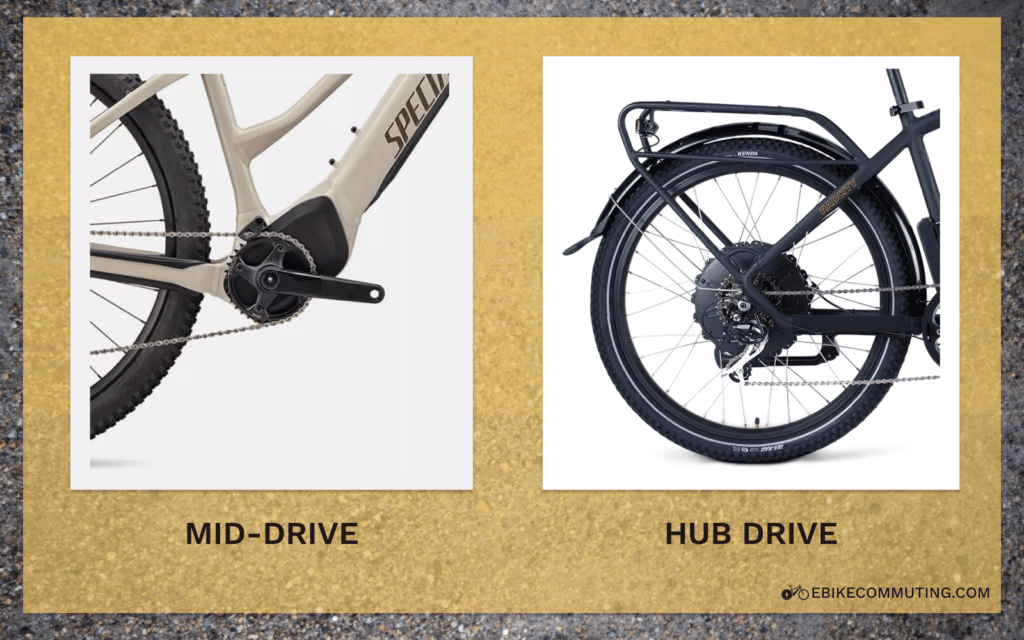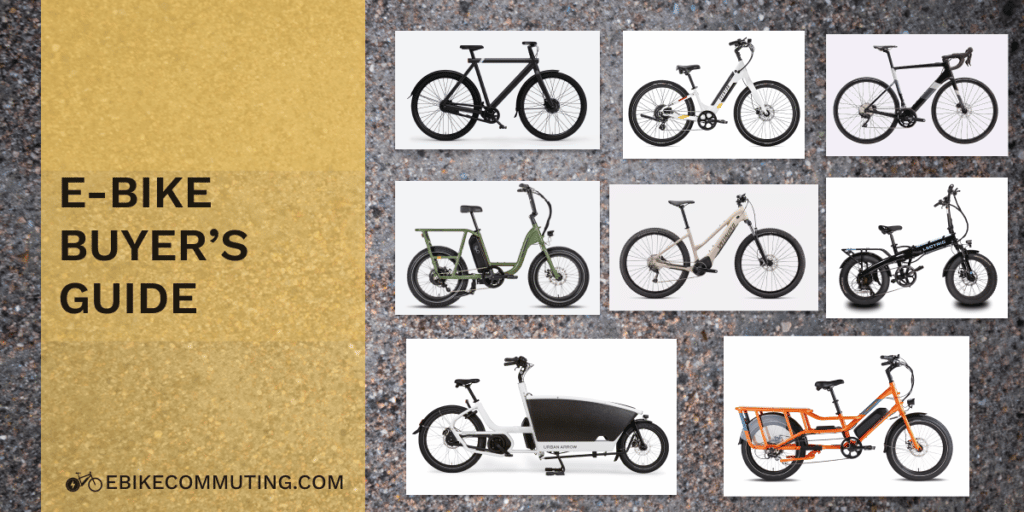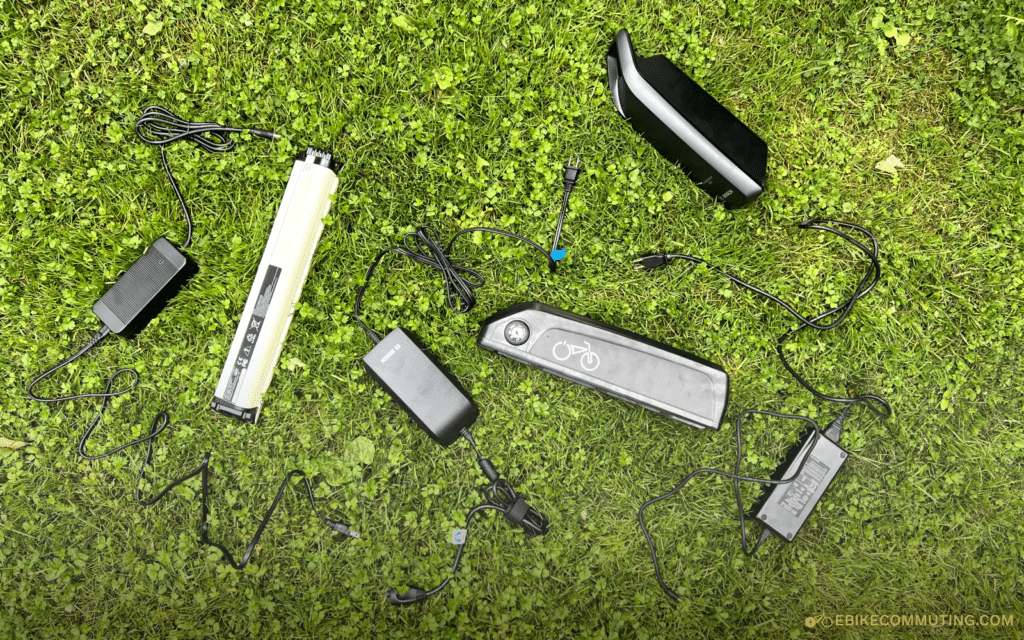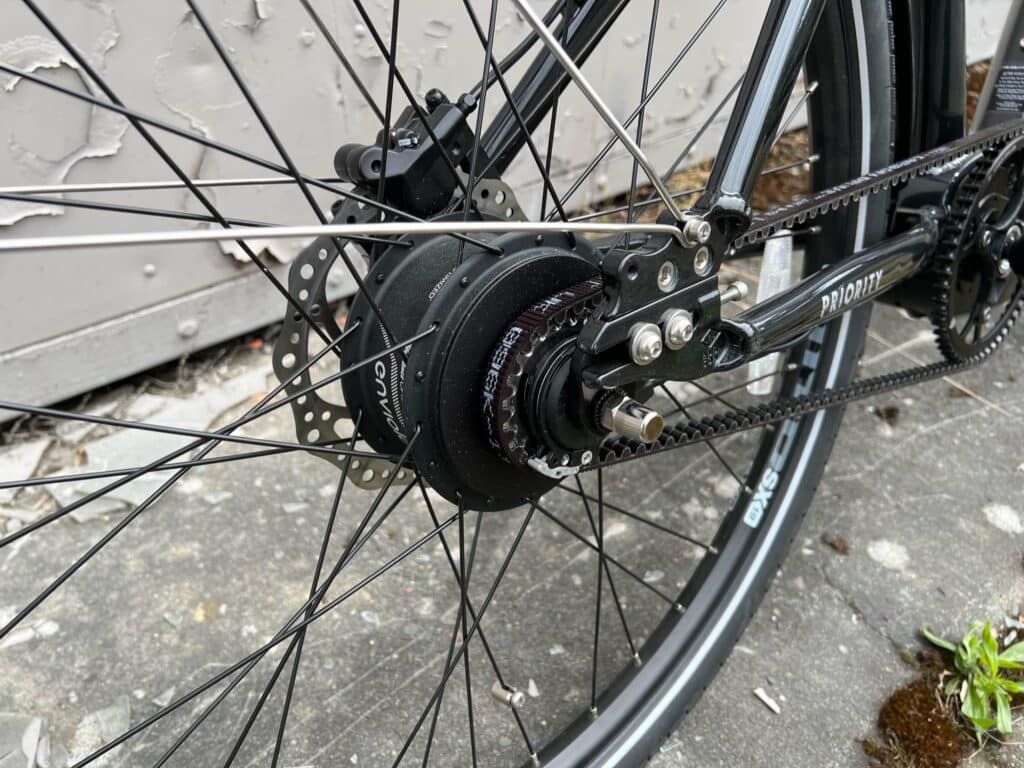When you are looking for a commuter e-bike, there are many decisions that you’ll have to make. This e-bike buyer’s guide covers the price ranges, styles of e-bikes, various features of e-bikes, and a few other considerations. It is meant to help you understand the tradeoffs so you can purchase the e-bike that is best for you and your commute.
Table of contents
How much should I pay for an e-bike?
There are three price tiers or ranges of e-bikes: Inexpensive (less than $1,000), Mid-range ($1,000 to $3,000), and High-end ($3,000+). This is an overview of the price ranges for e-bikes and what to expect in each price range. In general, “you get what you pay for,” when it comes to e-bikes.
Inexpensive (<$1k)
In general these are sold direct from Amazon or Alibaba. The e-bike components and motor are not usually from a known and trusted manufacturer, meaning the components are more likely to need frequent minor repairs or tweaks. Some people find it difficult to convince a local bike shop to repair these inexpensive direct to consumer bikes. We recommend that you ask a few local bike shops around town before purchasing one of these bikes, or be ready to become your own mechanic. The batteries tend to be unreliable and poor at holding a charge, resulting in rides cut short. We tend to steer our family and friends away from e-bikes in this price range due to their unreliability (the e-bikes not our friends 😃).
Mid-range ($1k to $3k)
The majority of e-bike manufacturers make e-bikes in the mid-range and the majority are direct to consumer companies aka DTC (Rad Power, Ride1Up, Juiced, VanMoof, etc). The e-bike components, motor, and battery are solid quality and make bikes in this range very reliable. In addition, mid-range DTC companies have better customer service than those in the inexpensive range. All e-bikes require regular maintenance on the gears and brakes every year and it’s a good idea to check with your local bikes shops to ensure they are willing to make repairs on your DTC e-bike.
High-end ($3k+)
Many of these bikes in this price range are the larger cargo e-bikes or e-bikes made by traditional bike manufacturers (Urban Arrow, Cannondale, Canyon, etc). These bikes are lighter, have a high-quality name brand motor (Bosch, Yamaha, Shimano), and have a solid range. The components are also usually from a reputable manufacturer and are more durable and more precise. This means that you won’t have to regularly make tweaks to the brakes or gears. The majority of these bikes are not sold by direct to consumer companies, and instead they are sold through traditional bike shops. The benefit of this is that you’ll have a bike shop that’s ready and willing to do the regular repairs and maintenance that are required of an e-bike.
What are the types of e-bikes?
There are many different styles or types of e-bikes, and our e-bike buyer’s guide lists the most common ones below. When deciding which one to buy, it’s important to think about your comfort, which is often related to the size, weight, and style of the bike.
Most e-bikes come in a variety of sizes. Because e-bikes can be heavy, it’s important that the e-bike is the right size and style for you. For example, you’ll want to be sure that the top-tube — the part of the bike that is between your legs when you are standing over the frame — is not too tall. You want some clearance between the top-tube and your body, so that it’s easy for you to get on and off. If you are on the shorter side, you should consider getting one that has a “step thru” frame, rather than the more traditional top-tube style.

Traditional crossbar e-bike
The traditional crossbar is the classic bike frame for over 100 years. The frame is the most common for e-bikes due to its versatility. Many come with shock absorbers on the front fork to reduce the impact of the bumps. Most people will find the riding position of a traditional crossbar bike comfortable for both short and long commutes. However, people who are shorter may find this frame challenging to get on and off unless you find a bike manufacturer that sells small frames.
Step-thru or “Dutch style” e-bike
Popularized by the Dutch, the step-thru or “Dutch style” frame was originally built for women’s bikes. It’s now a unisex frame style due to the ease of getting on and off the bike at stops. Step-thru frames are great for all sizes of riders. Your riding position will be upright and relaxed. Most of these bikes have plush tires and saddles for comfortable riding.
Mountain e-bike
Mountain e-bikes are full frame or front fork suspension bikes designed for off-road use. The tire width is wide and so are the handlebars for improved stability and control. The knobby tires will feel slow on roads, so we don’t recommend this style for someone looking for a strict commuter e-bike, unless you live in the mountains and your commute involves dirt trails.
Road e-bike
Road e-bikes are designed for long (50+ mile) rides on the road. They don’t have suspension so you’ll feel all of the little bumps in the road, but they climb hills beautifully fast. Your riding position will be much more aggressive and leaned forward. This bike is built for speed and distance so you may find the tire width to be too narrow for those rainy fall commutes where it’s better to have a bit more stability for the wet roads.
Midtail utility e-bike
Midtail utility bikes are very similar to the step-thru frame, described above, but they have a slightly longer and reinforced area above the rear wheel for increased cargo capacity. Many of these bikes often have an option to be configured with a padded rear seat and handlebars so that an adult or kid can ride on the back. Because of their increased carrying capacity, these bikes are much heavier than most other e-bikes (50+ lbs).
Longtail cargo e-bike
The longtail cargo style bikes have a smaller rear tire with a bench seat above them. The bench seat can be used to carry up to two kids or used as cargo storage. Oftentimes Longtails come with cargo bags that run along the sides of the bench seat (sort of like panniers). This means you can have kids on the bench seat and their feet dangling above the storage bags with their gear in it. You can also add a front cargo rack for additional storage. Longtails are typically lighter and easier to maneuver than Bakefiets style cargo bikes. One downside of Longtails is that the kids are behind you, rather than in front, so you can’t see them as well. Another downside is if you add storage bags, your kids’ feet will hit them while they sit on the bench.
Bakfiets or cargo box e-bike
Bakefiets is Dutch for “Cargo bike,” and this style is most common in Europe. Bakefiets are long e-bikes with a small front wheel and a cargo box in the front of the e-bike. These cargo bins range in size but most can fit two kids easily with extra space for your gear or groceries. Some cargo bins can even fit four kids. Most Bakefiets have 5-point child harnesses which are more secure than the lap belts typically found on Longtail bench seats. Most Bakefiets have better rain covers that provide 100% coverage than the Longtail bench seats (but not all).
One downside of Bakefiets is that they can be on the heavier side, but because they have a low center of gravity due to the cargo bin, they aren’t that much different to handle.
Folding e-bike
Popularized by commuters in the 90s, folding e-bikes fold down making them easier to carry and store in an apartment or take onto public transit. That being said, e-bikes that fold are still heavier than traditional folding bikes. Often, these bikes are upwards of 65 pounds, so it still takes a lot of strength and stability to lift and maneuver the folded bike. In general we don’t recommend this style unless you live in a walk-up apartment with limited storage space.
What should I consider when buying an e-bike?
There are a variety of things that you’ll have to consider and decide between when it comes to buying an e-bike. This guide covers the big ones: speed and pedal assist classes, mid-drive vs. hub drive motors, cadence vs. torque sensors, throttle vs. pedal assist, gearing and drivetrain, and battery and range.
E-bike classes for speed and pedal assist
E-bikes fall into three classes when it comes to their speed and pedal assist:
- Class 1: Max speed of 20mph. The electric motor only provides power when you are pedaling the bike. Some of these bikes might have a throttle, but it will only provide a boost when you are also pedaling.
- Class 2: Max speed of 20mph. The electric motor provides power when you are pedaling the bike or when you are using the throttle without pedaling.
- Class 3: Max speed of 28mph. There are generally more restrictions on the use of this kind of e-bike. It varies by U.S. state, but some states allow you to have a throttle on a Class 3 e-bike and some do not allow a throttle. Some multi-use trails restrict Class 3 usage, so you’d need to be mindful and ride slower. If you are considering a Class 3 e-bike we recommend that you check your state and local laws to figure out what type of Class 3 is allowed.
You may see manufacturers touting e-bikes that go faster than 28mph. If you want to go faster than 28mph it’s our opinion that you should be buying a moped or scooter.
Motors: mid-drive vs. hub drive
There are two common types of motors that provide power to an e-bike. Mid-drive motors are located in the thru-axle where the pedals connect to the frame of the e-bike. Hub drive motors are located in the center of the rear wheel.

Benefits of mid-drive:
- Feel more natural as you pedal because the motor is located close to your pedals.
- Has more torque meaning it can accelerate faster
- Takes better advantage of the bike’s gearing, useful when you need to climb a steep hill
Benefits of hub drive:
- Typically less expensive than mid-drive motors
- High durability and reliability
- Supports regenerative breaking so that you get a small bit of battery charge back when you break (but mostly negligible)
Motors: torque
A lot of people when they analyze e-bikes primarily look at how many watts a motor produces. And a 500 watt motor is a solid motor. But, in my opinion torque is way more important. Torque is what helps you accelerate from a stop and also what helps get you up a hill. Frankly, it doesn’t matter how many watts your motor has if the torque is low.
Now, you might ask what is considered low torque? Well in general e-bikes can be put into 3 groups based on their torque

First, are e-bikes that hav less than 40 Nm. These are e-bikes made for flat city commutes or gently rolling hills. These are for leisurely rides.
Second, are e-bikes with torque between 40 to 60 Nm. These bikes can handle hills pretty well and have good acceleration on the flats roads.
The third bucket of e-bikes are ones that have more than 60 Nm of torque. These will tackle hills easily and accelerate quickly.
As I live in Seattle, which has a lot of hills, I prefer e-bikes with more than 60 Nm of torque. When I ride e-bikes with less than 60 Nm of torque, I find it much harder to climb hills, especially since I weigh 180 pounds. Therefore, I need more torque to make my rides easier.
Cadence vs. torque sensors
Sensors tell the motor how much power to output. Why should you care about this? Because it can affect how jerky or smooth the bike feels when you pedal. One analogy is that it’s similar to a gas pedal in a car, the sensitivity of the gas pedal in a car varies car to car.
The two most common sensors are cadence and torque. Torque sensors have the most natural feel because they match or magnify the amount of torque you are producing when you pedal. Meaning, when you pedal softly, the pedal assist matches that to give you a small boost, and when you pedal hard, you get a large boost. In contrast, a cadence sensor merely applies power when it sees you turn the pedals. It doesn’t care about how much force you are applying. This means you can ghost pedal (pedal lightly) and it will apply full power. Cadence sensors often have a delay between when you pedal and power is applied. The majority of high-end e-bikes comes with torque sensors.
Throttle vs. pedal assist
All e-bikes have pedal assist, some also have a throttle on the handlebars. A throttle engages the motor and applies power regardless of whether you are peddling. Throttles are a convenient addition and make it easier to get started at a red light or stop sign, especially if your e-bike uses a cadence sensor which will be a little slow to provide power. Throttles aren’t make or break, if you find an e-bike that seems like a good fit for you and it doesn’t have a throttle, that’s okay.
Gearing & drivetrain
Gears help you pedal your bike more efficiently so that you can get up hills more easily. The drivetrain transfers the force you apply to the pedals through a chain to the gears which then turn the rear wheel.
Our ideal e-bike setup is an internal gear hub with a belt drive. They are going to provide the best quality riding experience, however they are more expensive. An internal gear hub takes all of the gears and derailleur you’d find on a regular bike and puts them in a weather sealed hub. While traditional gearing requires you to be pedaling to change gears, internal gear hubs allow you to change gears while stopped. Belt drives replace the greasy chain. They are quiet and smooth when you pedal, and require little maintenance.
Many of the less expensive e-bikes will be single speed (no gears) or have traditional geared cassettes. If you have a hilly commute having gears is very helpful to ensure that you are able to help pedal up the hill and not relying solely on the motor.
Battery & range
Battery range and power are important considerations when you are purchasing an e-bike for commutes. Meaning, does the bike have enough range to get you to and from work on a single batter charge? We tell our friends to take the minimum range on the company’s website, divide it in half and see if that will get you to and from work. This means you’ll still be able to get to work if you forget to charge on a given night or you can use full power when you are in a hurry. So, let’s say the bike’s range is listed as 30 to 50 miles. If your roundtrip commute is 15 miles or less than that is perfect. You’ll still be okay if your commute is longer, you’ll just need to pay more attention to what pedal assist setting you have it on and if you fully charged the battery the night before.
Other considerations
Maintenance & repairs
You should check your tire pressure at least once a month. Purchase a good quality floor pump that has a PSI gauge, such as Park Tool Home Mechanic Floor Pump. You’ll be able to find the e-bike’s recommend PSI range on the sidewall of the tire.
Similar to traditional bikes, you should get your e-bike tuned up at least once a year, ideally twice a year. The primary thing to have checked are the brake pads, brake levers, tire wear, chain wear, and all the various bolts to ensure they are still tight.
Historically, many people have struggled to get their e-bikes repaired at their local bike shop, however with the prevalence of e-bikes that is rapidly changing.
Higher end e-bikes are sold directly from a bike shop so you’ll have a place to get your e-bike maintenance completed.
If you are considering buying an e-bike from a Direct to Consumer brand, we recommend that you check with a few local bike shops to see if they are willing to do maintenance and repairs. If not, be prepared to teach yourself how to become a bike mechanic, while not impossible, it certainly takes some practice to get the hang of it and there’s a risk that you mess up something critical, like your brakes. In addition, do some research on the bike manufacturer’s customer service reputation. While they won’t do the physical repairs, they should be able to help you troubleshoot basic problems with their e-bikes.
Accessories
The most important accessory that you’ll need to purchase is a good quality helmet. We recommend the BERN Watts 2.0 MIPS Cycling Helmet.
You will probably also want to get a bike lock. We use and love ABUS uGrip Bordo 5700 Folding Lock. They aren’t the most secure, but they are super convenient to have strapped to the frame of the e-bike directly. If you plan to leave your e-bike on a city street for multiple hours then consider looking for a very secure lock. If you are only locking it up outside of the grocery store or in a secured parking lot bike locker, then a folding lock will probably suffice (it’s what we use!).
It’s also worth taking a look through the company’s accessories for the bike, such as cargo racks, panniers, and rain fenders. A good quality company will have a wide range of accessories for your e-bike to help you customize it. This doesn’t mean you have to buy all of the accessories on the first day or directly from the company. Ride your e-bike for a few weeks and figure out what you think would make it better. In general, we recommend that people budget an additional $200 to $500 in accessories to ensure a good commuting setup.
Kid’s accessories
E-bikes designed with kid passengers in mind, such as midtail, longtail and bakefiets will require additional accessories to be purchased to ensure a comfortable ride for them. This may include bench seats, railings or handholds, foot platforms and a rain cover. These all add to the cost of the bike and are often not included in the list price.
If you are carrying kids on your bike, you’ll also need some storage space for all of their stuff. We like to use a front cargo rack with a webbing to keeps things secured.
For toddlers, there are two types of child carriers: one that is a small saddle like seat that attaches to the frame in the front of the e-bike and one that is a seat that goes on the back of the e-bike. The back seat is most traditional and its wider acceptable weight range means it fits a wider age of kids.
We recommend the Thule Yepp Seat. It’s made of very sturdy, but comfortable material, it’s easy to adjust the foot holsters and shoulder harness. It also comes in some great colors! We are partial to the blue.
Some e-bike brands, such as RadPower, have rear racks that are purposefully built for these bike seats, which make it a breeze to install and switch between e-bikes if needed. Other brands might require you make modifications to the rear e-bike rack.
We hope you found this e-bike buyer’s guide helpful! Be sure to check out our post “The Best E-Bike for Commutes in 2023” and “The Best Cargo E-Bike for Commutes with Kids“



thanks for the explanation of torque versus watts. very helpful and also how much torque i will need for hills.